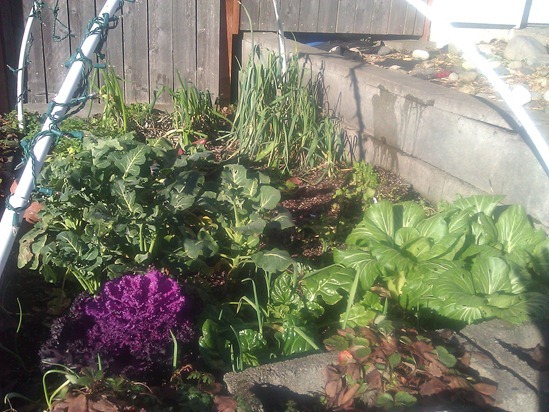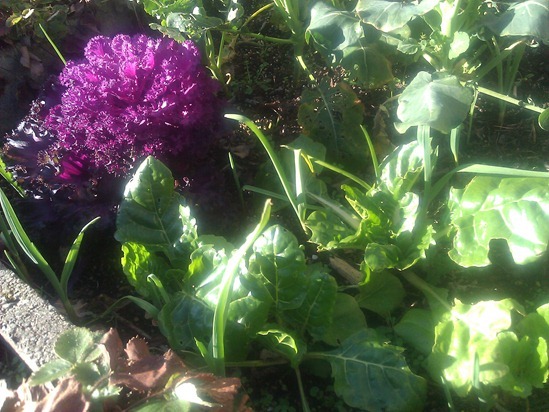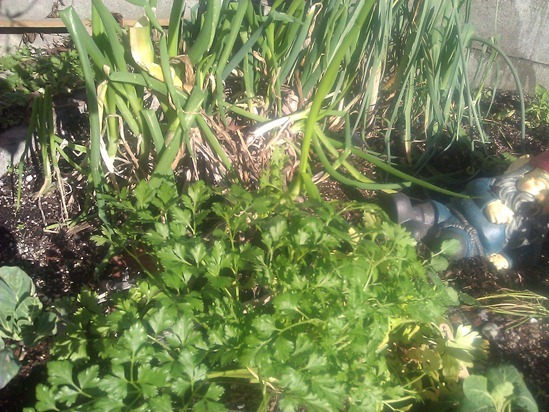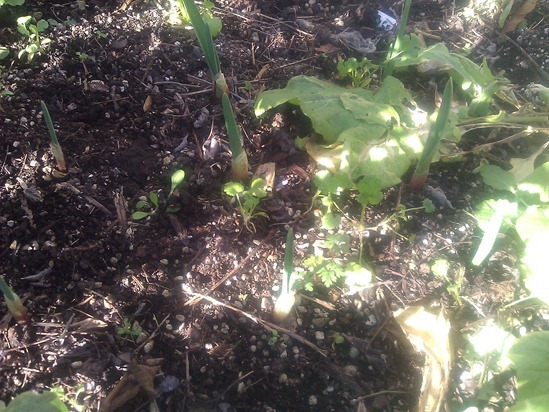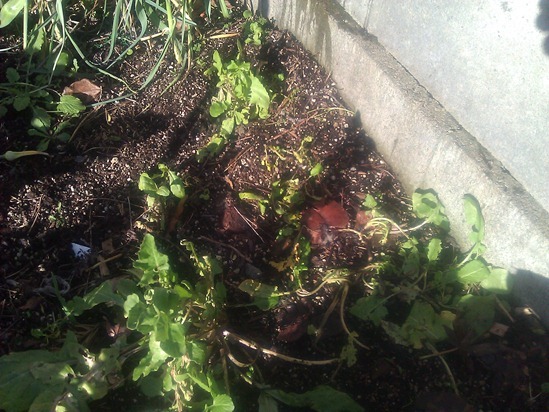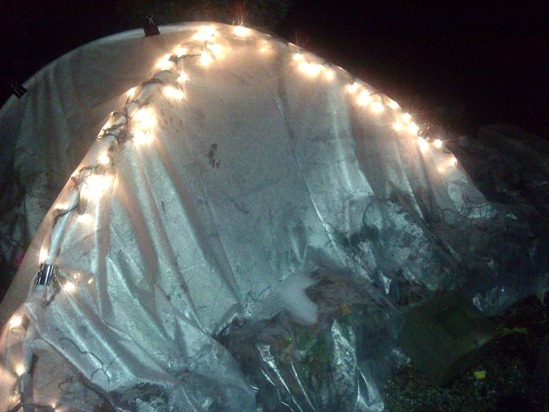How to Prepare Your Vegetable Garden for a Harsh Winter
10.5 years ago carrot, garden maintenance, guest post, kale, winter garden
According to Game of Thrones fans everywhere, winter is coming. And while this may mean snowmen, Christmas decorations and mulled wine for some, for the keen gardener it can mean fingernails bitten to the quick and sleepless nights worrying about cabbages.

Image credit: vegetable garden
Well, maybe we wouldn’t go quite that far – but after all the effort you’ve put into your vegetables, you won’t want your hard work to go to waste for next year. Fear not – we’ve got a guide on how to make sure that your vegetable garden is both ready for next year and useful throughout winter. Here’s how…
Harvest
First things first, take in all of the vegetables that are ready to be harvested and make the most of them. Make sure that you cure and store your produce properly, and you might just end up with a stash that will last all winter long!
Clear out
After you’ve collected all of your delicious vegetables but before you get started on the chutney, it’s time to clear up your yard. If you’re tempted to put this job off, think of it as a treat for your future self when you’re planting more vegetables in the spring. You’ll be glad you put the groundwork in when May rolls around! While you’re there, prepare perennial vegetables for survival by removing old foliage and stems.
Make your garden useful throughout winter
Though it may seem like all plants are dead in winter, there are a few vegetables that will actually be ready for harvesting when it’s very cold outside, so with a little preparation and clever planting you can make your garden produce food until late in the season.
- Carrots are actually sweeter when harvested after the frost. Plant them around late August or early September and cover them with straw for a little insulation.
- Plant kale and collards in mid-August and harvest young leaves from October onwards.
- It’s best to plant Spinach around four to six weeks before the first frost of winter – again, cover with straw, then harvest in late winter or early spring.
- November is the ideal time to plant overwintering onions.
- Don’t have space in the pantry for all of your produce? Don’t worry – your garden can act as a fridge. Bury cabbages, with their roots still attached and a marker in the soil above so you don’t lose them, and dig them up when you fancy bubble and squeak. Potatoes and carrots will also keep when buried in the garden, but add some straw over the top to protect them.
- Give your vegetables lots of compost and a layer of mulch, for nutrients and protection. And, while the soil is a great protector for vegetables – especially root vegetables – it won’t hurt to give them a little water before a big freeze, when it may be difficult for your plants to reach water. However, be wary of over-watering, which can lead to cold, soggy roots and very unhappy plants.
Plant a cover crop
You may not be using your whole garden to grow overwintering vegetables, so to keep your soil ship shape and ready for spring it’s a good idea to plant a cover crop such as buckwheat or rye. These plants will suppress weed growth, feed bees and keep soil in place, then they’ll act as a ‘green manure’ for your garden by breaking down and providing your soil with lots of lovely nutrients.
About The Author
This guest post was written by Ricky Peterson. Ricky is a keen gardener and loves spending time outdoors, he works at Swallow Aquatics, who sell various pond and garden supplies. Ricky also likes to travel and loves hiking and climbing.
Growing Your Own Kale in the Garden
10.6 years ago kale, winter garden

Kale is a vegetable that is up and coming in American society, both in restaurants and in the home kitchen. My favorite way to prepare it involves flash grilling over my fire pit and a homemade Caesar dressing, but the options are limitless.
Many people think that Kale is best grown in cooler areas, and while this is sometimes true, it is in fact a crop that can grow across a wide range of locations in virtually all seasons. Whether you’re planting from seeds or pre-grown starts, this veggie isn’t hard to grow and provides plenty of nutrition to make the process worth your time.
While you as the grower can decide how technical you want to get when growing kale, there are some basics below in case you’ve never grown anything similar. While the duration of seed to harvest will be determined by a number of factors, here are some tips to get you from start to finish.
1. Preparing the right soil
Kale grows best in moist but not damp soil, with mid-level pH and not too firm structure. The plant likes the ability to have space within the ground, but not too much. This veggie will grow in a plethora of soil conditions, but can become increasingly bitter if placed in compromising conditions.
Take home: Find a good soil and keep it moist. If it’s too acidic, add some wood ash or some other natural substance to neutralize it. You’ll be good to go!
2. Determine ideal positioning in garden by season
While kale can grow across seasons, it’s beneficial for you to consider the position of your planting with relation to the weather. If it’s the middle of summer, find a spot where a certain amount of shade will be offered on a given day. If it’s fall, aim for a spot that will receive constant sunlight. Balance is key for kale!
Take home: Kale grows much more efficiently and becomes more delicious with proper positioning. While avoiding over analyzing the situation, use good judgment and plant it where you think it has the best chance at growth.
3. Focus on keeping the soil moist
Kale really flourishes with moist soil, and it’s imperative that you keep it satisfied. If not, the leaves can become brittle and bitter to the taste. When then plant is just under a foot high, you can begin cutting the leaves off, but be sure to maintain watering all the way through the journey.
Take home: Most plants thrive with moisture. Kale is no different. While this vegetable can and will grow in a variety of situations with a wide range of unique methods, for optimum results, moisture is your ticket to sweet kale.
Regardless of whether you’re aiming to make bulk amounts of kale Caesar salad like me, or simply want to grow a nice veggie for your early fall family reunion, kale is a forgiving plant that will be sure to please the crowds.
Mackenzie Kupfer is a writer and gardener. She’s been growing tasty treats like kale in her yard for many years and likes to spread the wealth of her ventures by sharing wisdom online and veggie dishes at home.
Tips for Getting Started with Year-Round Gardening
10.6 years ago raised garden, winter garden
As many of us grow more environmentally conscious and feel an increased concern about exposure to chemicals and toxins, one appealing option for wrestling back control over what goes into our systems is to grow our own fruits and vegetables. However, the steps involved in planting, maintaining, and harvesting a successful crop can feel daunting, especially to those of us who have had trouble keeping household plants alive in the past.
The key to overcoming this anxiety is simple: by employing a few simple techniques, planning ahead and creating a manageable chart of necessary activities, it will be easy to keep your garden blooming year-round.
Step One: Decide What to Plant and When
Because you’re going to be a year-round gardener, any time is a good time to figure out which plants to grow in the coming season. Which ones you choose will be dependent to a large extent on where you live. Different vegetables thrive at different times of year and in different climates. Consult your local gardening organization or gardening center for advice concerning which crops are most advisable for your particular location.
Certain hardy crops can be planted as early as February, while warm season crops should generally go into the ground after the last average frost date. By late summer, you can plant crops for your fall garden – these should go in at least two months before you expect the earliest fall frost. Certain crops like garlic and onions can be planted as late as October! The key is to keep planting throughout the year, so that you can also harvest vegetables year-round.
Step Two: Create a Gardening Chart
Create a gardening calendar with sections for each month of the year. Here is an example of a basic planting guide that was prepared for gardeners in Central Arkansas: http://www.uaex.edu/Other_Areas/publications/PDF/FSA-6062.pdf. Another example focuses less on which vegetables to plant in which month and much more on the activities that are needed to maintain a garden: http://www.humeseeds.com/projndx.htm.
A different option is to create a chart with rows for each month and columns for different types of things to do in the garden. For example, you could have a column for planting, another for maintenance activities, and one for harvesting. This means that for April, you could look at column one to see which plants to put in the ground, column two to see how often to water or fertilize them, and column three to check on which plants should be ready to be harvested.
Step Three: Use Techniques That Enable You to Extend the Growing Season
There are many methods of extending the growing season of your garden. Three basic ones that will be discussed here are:
- Raised bed gardening
- Planting seeds indoors
- Plastic-covered tunnels
Other options you might wish to explore include cloches, cold frames, underground greenhouses, and solar-charged hot water bottles.
To begin with, raised bed gardening offers several advantages. In particular, raised beds allow you to extend the gardening season because the soil will warm up earlier, meaning you can start growing crops sooner. Additionally, because the beds are raised off the ground, it is not as difficult to work on the garden in rainy weather. This type of garden also typically offers higher yields and better soil.
Raised bed gardens even require less water and generally contain fewer weeds. You can purchase or build raised beds, or even create them by shaping rectangular mounds of soil a few inches above the ground level so that they are wide enough to reach across. However, make sure to use sufficient mulch to keep the soil in place if it rains heavily.
Next, planting seeds indoors allows you to multiply the number of planting seasons available to you. Instead of winter, spring, summer, and fall, you will have early spring, mid-spring, late spring, summer, early fall, late fall, and winter. By starting the plants inside and only moving them to the garden when other plants are harvested, you can make use of more limited space. The key is having a firm plan for garden layout and crop rotation.
Finally, this technique can be supplemented by using plastic-covered tunnels for mini-greenhouses. Not only will this allow you to plant earlier in the spring, it also provides a place to harden the tender seedlings you have been growing indoors while you are waiting for space to open up in the garden. You can use fence wire to support the tunnels; another option is to use hoops cut from wood, wire, or pipe. In addition, cover the tunnels with blankets or tablecloths when it is especially cold and cut V-shaped vents in the sides in order to improve ventilation.
What vegetables would you like to grow in your garden? Have you had success with year-round gardening in the past?
Since 2000, Chris Long has been a store associate at a Home Depot in Illinois. He also contributes to the Home Depot blog, and provides raised bed garden advice as well as tips on other home landscaping topics.
How to make a home garden greenhouse
11.5 years ago greenhouse, guest post, winter garden
As the world is speeding up its pace of development every second, we are losing many important things on earth. Saving environment where we live is the need of the hour. We are losing so much greenery every hour around the world that the time is not far when greenery will be hard to find. Though governments are making efforts to save the environment, it’s not enough- our efforts value the most. Greenery is very important for humans life cycle as it takes in carbon dioxide and give us oxygen to breathe in.
Greenhouses are generally built to somewhat gain control over the environment suitable for plants. Greenhouses are generally build to create an atmosphere for growing off season vegetables all-round the year. One can easily make greenhouse garden at home with some easy to make a home garden greenhouse. Below are a few popular varieties you can create yourself or purchase a kit to save a considerable amount of money.
Frames
The greenhouse frames are of three types- the “Quonset” which is simple tunnel shaped, ridged beam with taller gothic shape having arched sidewalls and third one with vertical side walls having able roof. Choice of greenhouse generally depends on cost and gardening goals. The ridged beam and Quonset are mainly for rookie gardeners who have less gardening experience.
Quonset
This basic inexpensive Quonset greenhouse structure is made from 1/2 inch PVC plastic pipe. Quonset is suitable for rookie gardeners who wish to increase the growing season and are interested in cultivating early spring seedlings. Quonset base is egg shaped, two-by-four frame directly placed on the ground. The roof has several half cut plastic lengths attached to each other with the insides of longitudinal base at distance of three to five foot. It comprises of a UV-resistant heavy plastic film, which is used for covering the roof. The walls at the ends have door frames with adjustable sliding doors on both ends providing access and ventilation to greenhouse.
Gothic
Gothic greenhouses are tall as compared to Quonset shape. They have central ridge and have arched sides. Gothic greenhouses provide better headroom and storage along with the sidewalls. This type of greenhouse can be raised on ground or concrete slab if user is planning to use growing tables or raised beds. In Gothic greenhouse wooden arches are used on inside edges of the base frame on longitudinal sides. Flexible polycarbonate or see-through panels made of fiberglass are fixed to wooden frames with screws. Adjustable sliding doors are used to cover ends for ventilation and access. Gothic greenhouses can be of great use to serious gardeners who want to increase the cultivation seasons up to four times.
Rigid Frame
These greenhouses are built by professional contractors. Rigid Frame greenhouses have permanent structure without supporting pillars in center. These types of greenhouses need building permit plan approvals. Rigid Frame greenhouses are built on concrete foundations with vertical sidewalls. They have full facility of controlling humidity, lighting heating and ventilation. Its exteriors are built with fiberglass sheeting, polycarbonate panels and glass. These greenhouses can be used for cultivation all-round the year and used by professional farmers and horticultural nurseries.
These are some of the garden greenhouses which one can make according to his/her requirements and budget.
About The Author: Alia is a journalist and blogger. She is a contributor to several sites such as Marnie Bennett.
Winter garden survivors
12.2 years ago bok choy, garlic bulbs, kale, winter garden
Saturday we had a rare occurrence here in the Pacific Northwest, this large ball of warm gas, which in some areas they refer to as the sun made an appearance. It raised the temperature so much I had to take the cover off my winter garden so I decided to do a little weeding and take some pictures.
The Chinese cabbage (bok choy) is looking great and I need to remember to cook with it shortly.
The kale and Swiss chard is also growing strong…think I might have some cooked greens in my future.
The parsley and onions needed a little cleaning up but still nice and green.
The garlic bulbs planted last fall are now starting to emerge with some stray cilantro in gabs between them.
The arugula is still alive but a little mangled from some of the snow that the hoop cover did not keep entirely off. For the beginning of February the garden looks the most alive it has ever been this time of year.
Cheap hoop house heating
12.3 years ago cold season crops, outdoor seed starting, winter garden
Before you put those Christmas lights away into storage you may want to keep a couple strings (non-LED) set aside to use for heating a hoop house. These little lights can help boost the temperature 5-10 degrees inside your enclosure, while this will not allow you to grow tomatoes and peppers during the wintertime. This may be enough to allow you to keep a winter garden for the whole winter and/or provide just enough warmth to bring out your spring seedlings a couple weeks earlier.





